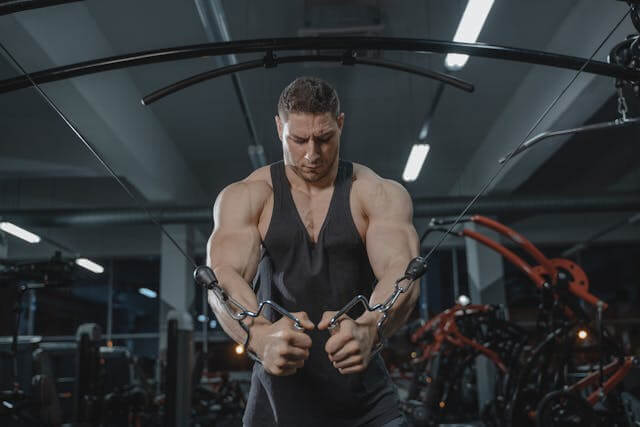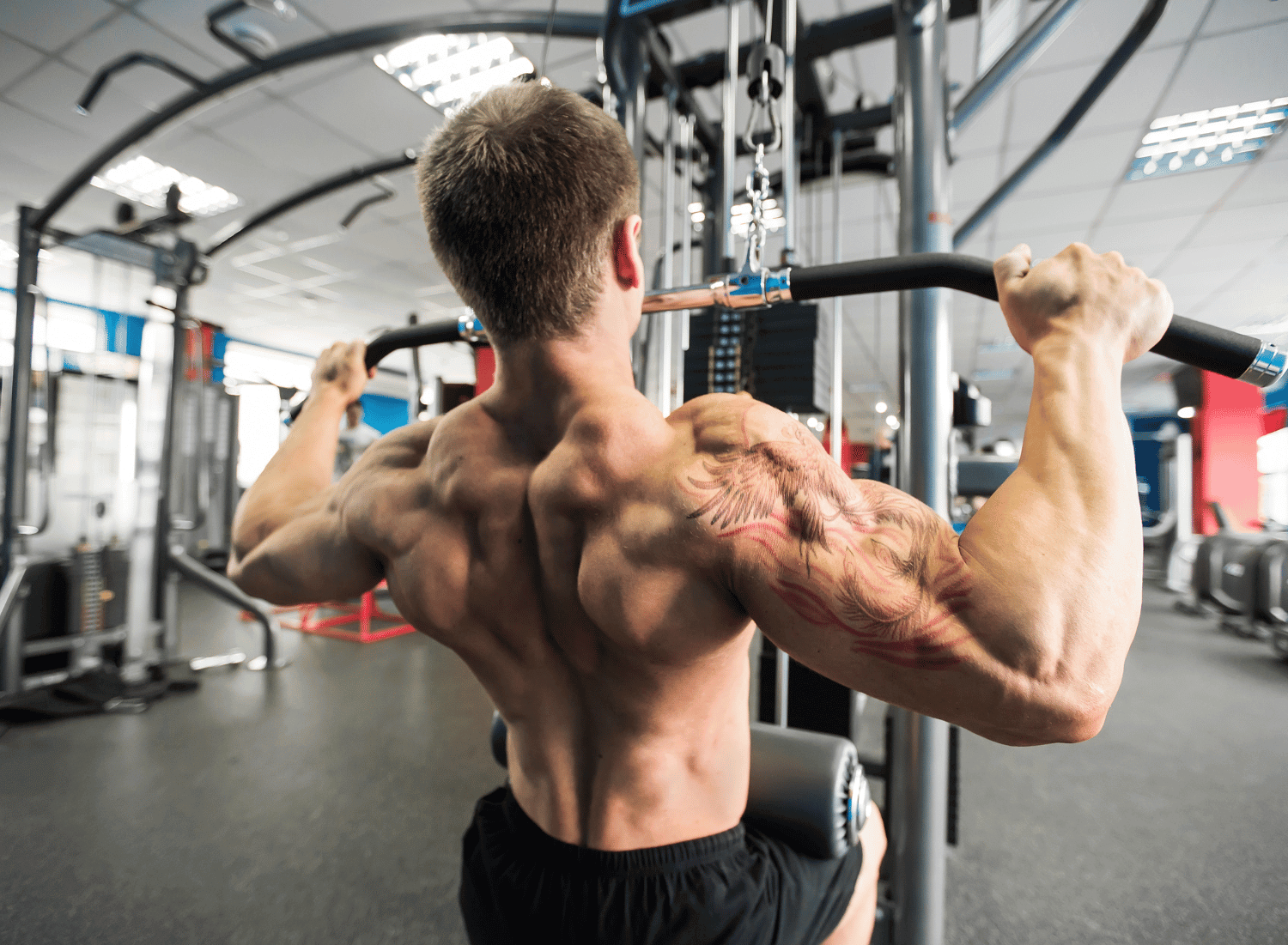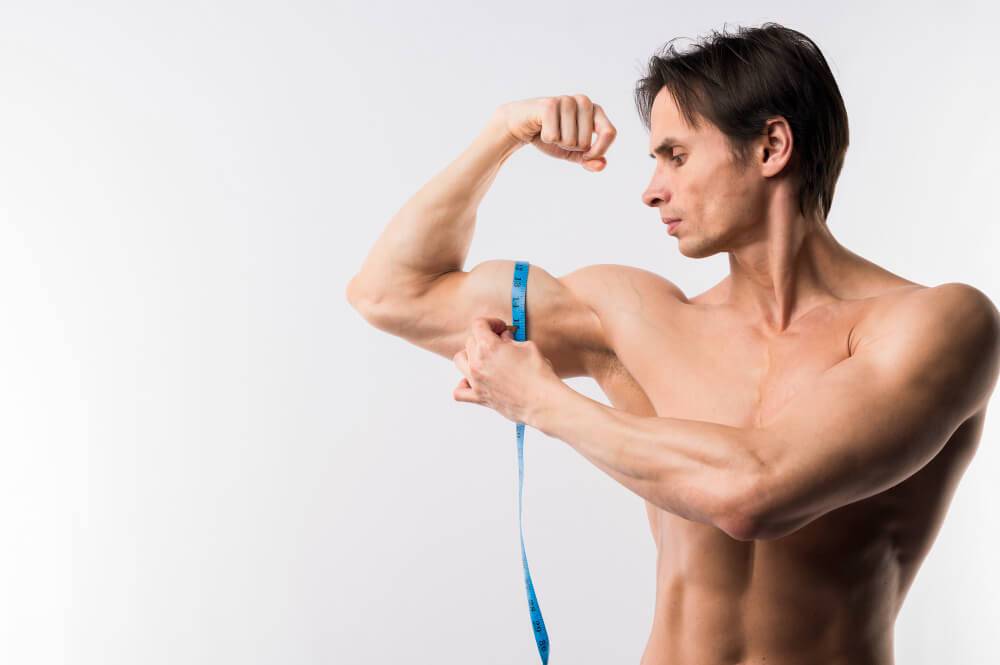If you’ve been searching for a way to turbocharge your muscle growth and elevate your workout game, look no further than the unassuming cable machine.
This extensive guide is designed for fitness enthusiasts eager to revolutionize their training regime with 13 intense cable machine exercises. I have listed 13 cable machine exercises in this article, if you want to know about more exercises then visit mirafit.co.uk. They have listed more than 30 exercises. Can also visit here.
Whether you’re a gym novice or a seasoned pro, these exercises, complete with instructions, form details, and variations, will help you bulk up, improve definition, and enhance functional strength. Ready to redefine your fitness routine? Read on.
Why Cable Machines?

The Versatility of Pulleys
Cable machines are a staple at gyms for good reason. Their pulley system offers constant tension on muscles that is more difficult to achieve with free weights alone. Resistance bands can deliver similar constant tension, but cable machines typically allow for greater weights, thus greater overload, as well as more varied attachment options.
Isolation and Stability
One major benefit of the cable machine is its ability to isolate muscle groups. The guided nature of the pulley system also increases stability, making it an excellent tool for those recovering from an injury or who are at the beginning of their fitness journey.
Eccentric and Concentric Training
Unlike free weights, which are primarily used for concentric training (muscle shortens as it contracts), cable machine exercises offer a great eccentric component (muscle lengthens under tension) as well, often neglected yet vital for muscle growth and injury prevention.
Best 13 Cable Machine Exercises
When it comes to muscle growth, not all exercises are created equal. The following 13 cable machine exercises are tailored to maximize the potential for muscle hypertrophy.
High Cable Crossover
Muscles Targeted:
The High Cable Crossover is a quintessential exercise for those aiming to carve out a prominent and defined chest. This exercise targets the pectoral muscles from an elevated angle, engaging the upper chest fibers and encouraging the development of a well-rounded chest. By performing this movement, you’re not only working on the primary muscle groups but also engaging your core and stabilizers, enhancing overall upper body strength and posture.
How to Perform:
- Set Up: Position the handles on each cable machine to the highest setting. Choose a weight that is challenging but allows you to complete 8-12 reps with good form.
- Stance: Stand in the center of the cable station with one foot slightly in front of the other for stability. Lean forward slightly from your hips, maintaining a straight back.
- Grip: Grasp each handle with your palms facing down. Your arms should be extended but with a slight bend at the elbows.
- Execution: Keeping a slight bend in your elbows, bring your hands together in a smooth, arc-like motion in front of your hips. Squeeze your chest muscles as the handles meet.
- Return: Slowly return to the starting position by reversing the movement, allowing your chest to stretch while controlling the weight.
- Breathing: Exhale as you pull the handles together and inhale as you return to the start.
- Repetition: Aim for 3-4 sets of 8-12 repetitions, adjusting the weight as necessary to maintain proper form and intensity.
Remember, the key to maximizing muscle growth with this exercise is to focus on the stretch and contraction of the chest muscles throughout the movement.
Cable Lat Pulldown
Muscles Targeted:
The Cable Lat Pulldown is an essential exercise targeting the latissimus dorsi, the broad muscles of the back, contributing to that coveted V-taper appearance. The controlled movement helps improve posture and back strength, which is vital for daily activities and other compound exercises.
How to Perform:
- Set Up: Adjust the cable machine to the lat pulldown attachment and select a weight that challenges you for 8-12 reps while still allowing for full control and proper form throughout each rep.
- Position: Sit down at the cable station and adjust the knee pad to fit snugly against your legs to prevent lifting during the exercise. Grasp the bar with a wide grip, hands placed farther than shoulder-width apart.
- Posture: While keeping a straight back, slightly arch your lower back and protrude your chest upwards. This is your starting position.
- Execution: Inhale and pull the bar down to your chest, leading with your elbows and keeping them pointed straight down. Concentrate on squeezing your lat muscles as you pull the bar towards you.
- Peak Contraction: Once the bar touches your chest, hold the position briefly, ensuring maximum contraction in your back muscles.
- Return: Exhale and slowly allow the bar to return to the starting position, feeling a full stretch in your lats as your arms extend upwards.
- Repetition: Aim for 3-4 sets of 8-12 repetitions, pausing to adjust the weight if necessary to ensure you’re working with the right intensity for muscle growth.
Focus on maintaining control throughout the exercise, especially during the return phase, to maximize the engagement of your lat muscles and promote effective muscle growth and strength. This kind of cable machine workouts builds your strength, focus and endurance.
Cable Face Pull
Muscles Targeted:
The Cable Face Pull is an exceptional exercise for targeting the posterior chain of the shoulder muscles, including the rear deltoids, rhomboids, and trapezius. Additionally, this exercise enhances shoulder stability and mobility, promoting a healthier shoulder joint and improved overall shoulder function.
How to Perform:
- Set Up: Adjust the pulley system to a height above your head and attach a rope handle to the cable. Choose a weight that allows you to perform 10-15 reps with perfect form.
- Grip: Stand with your feet shoulder-width apart, a few steps away from the cable machine. Grasp the rope with both hands, palms facing each other. Extend your arms fully at the start.
- Stance: Lean back slightly, rooting yourself with a slight bend in your knees to maintain balance throughout the movement.
- Execution: Begin by pulling the rope towards your forehead, separating your hands as you pull. Elbows should move out to the sides, not just backwards, to fully engage the rear deltoids and upper back.
- Peak Contraction: Once the rope reaches your forehead or just before, pause to squeeze your shoulder blades together, emphasizing the contraction in your rear deltoids, rhomboids, and traps.
- Return: Slowly extend your arms back to the starting position, controlling the weight with a steady pace to ensure a full stretch in the target muscles.
- Breathing: Inhale as you begin the movement, and exhale while pulling the rope towards your face to maximize core stability and engagement.
- Repetition: Aim for 3-4 sets of 10-15 repetitions, focusing on form and the quality of muscle contraction over the quantity of weight.
Remember, the focus of the Cable Face Pull is on the control of the movement and the squeeze at the end, not on the amount of weight used. This exercise is essential for improving posture, enhancing the appearance of the upper back, and contributing to overall shoulder health and stability.
Triceps Pushdown
Muscles Targeted:
The Triceps Pushdown is a staple exercise in arm training, specifically designed to target and isolate the triceps brachii muscles. Want to know more about lateral head of triceps exercises, then click here. This exercise is essential for several reasons.
First, it contributes to the overall strength and aesthetics of the arm by providing shape and definition to the triceps, which comprise a significant portion of the arm’s mass.
Second, strong triceps are vital for the improvement of performance in various compound upper body exercises, such as the bench press and push-ups, by enhancing stability and power.
Lastly, incorporating the Triceps Pushdown into your routine promotes balanced muscle development, preventing potential muscle imbalances and reducing the risk of injuries.
How to Perform:
- Set Up: Position yourself at a cable station with a high pulley and attach a bar or rope handle. Select a weight that will allow you to perform the exercise with good form for 8-12 reps.
- Grip: For a bar attachment, grasp it with an overhand grip (palms facing down) about shoulder-width apart. If using a rope, hold the rope with both hands so that your palms face each other.
- Starting Position: Stand upright with your feet shoulder-width apart and a slight bend in your knees for stability. Keep your elbows close to your body, and position your elbows at a 90-degree angle with your forearms parallel to the floor.
- Execution: Exhale as you push the bar or rope down until your arms are fully extended, focusing on moving the weight with your triceps. Keep your elbows stationary and close to your body throughout the movement.
- Peak Contraction: Once your arms are fully extended, hold the position for a brief moment to maximize the contraction in your triceps.
- Return: Inhale and slowly return the handle or bar to the starting position with your forearms parallel to the floor, maintaining control of the weight to ensure the movement is focused on your triceps.
- Repetition: Complete 3-4 sets of 8-12 repetitions, adjusting the weight as needed to ensure you’re challenging your muscles while keeping strict form.
By adhering closely to these steps and maintaining proper form throughout each set, you’ll maximize the efficacy of the Triceps Pushdown, leading to improved triceps strength, definition, and overall arm aesthetics.
Cable EZ Bicep Curl
Muscles Targeted:
The Cable Bicep Curl is an effective exercise for targeting the bicep muscles, enhancing both their strength and appearance. Incorporating the Cable Bicep Curl into your workout regimen can lead to better muscle isolation, improved form, and increased hypertrophy, contributing to stronger, more defined arms.
How to Perform:
- Set Up: Stand in front of the cable machine and attach a straight bar or EZ curl bar to a low pulley. Choose a weight that allows you to complete 8-12 repetitions with proper form.
- Grip: With your palms facing up, grasp the bar with both hands. Your hands should be about shoulder-width apart to ensure a balanced load on both biceps.
- Starting Position: Stand up straight with a slight bend in your knees for stability. Keep your elbows close to your torso, and your arms fully extended at the beginning.
- Execution: Exhale as you curl the bar upwards towards your chest, keeping your elbows stationary and only moving your forearms. The movement should be smooth and controlled.
- Peak Contraction: Once the bar is at shoulder level, squeeze your biceps hard at the top of the motion for maximum muscle engagement.
- Return: Inhale as you slowly lower the bar back to the starting position, keeping your arms under tension throughout the descent.
- Repetition: Aim for 3-4 sets of 8-12 repetitions, adjusting the weight as necessary to maintain form and intensity throughout your sets.
Remember, the key to the effectiveness of the Cable Bicep Curl lies in maintaining constant tension on the biceps and focusing on form over weight. This exercise, when executed correctly, can significantly enhance the size and strength of your biceps, contributing to a more balanced and aesthetically pleasing arm development.
Cable Bicep Hammer Curl
Muscles Targeted:
The Cable Bicep Hammer Curl is a unique exercise that targets not only the biceps but also the forearms, particularly the brachioradialis muscle. This exercise is crucial for several reasons.
Firstly, it provides a comprehensive upper arm workout, enhancing both strength and muscle definition by engaging different muscle groups simultaneously. The hammer grip used in this variation emphasizes the brachialis and brachioradialis, muscles that are not as heavily targeted in traditional bicep curls, leading to a more well-rounded arm development.
Secondly, the constant tension provided by the cable machine ensures that the muscles are engaged throughout the entire range of motion, maximizing muscle growth and the efficiency of your workout.
Lastly, incorporating Cable Bicep Hammer Curls into your arm workout regimen can improve grip strength and forearm aesthetics, contributing to improved performance in both pulling and lifting exercises.
How to Perform:
- Setup: Position yourself at the cable machine with an appropriate attachment (rope or dual handles) connected to a low pulley. Select a weight that challenges your muscles while still allowing you to maintain proper form for 8-12 reps.
- Grip: Hold the attachment with both hands using a neutral grip (palms facing each other).
- Starting Position: Stand with feet hip-width apart, knees slightly bent for stability. Start with your arms fully extended and the weights just off the stack.
- Execution: Exhale as you curl the handles upwards towards your shoulders, maintaining the neutral grip and keeping your elbows tight to your sides. Focus on utilizing your biceps and forearms to perform the movement.
- Peak Contraction: At the top of the curl, squeeze your biceps and forearms for a moment to maximize muscle engagement.
- Return: Inhale and slowly lower the handles back to the starting position, controlling the weight throughout the descent.
- Repetition: Aim to complete 3-4 sets of 8-12 repetitions, adjusting the weight as necessary to ensure form and effectiveness are maintained.
Following these steps will help you effectively target and strengthen your biceps and forearms with the Cable Bicep Hammer Curl.
Standing Cable Ab Crunch
Muscles Targeted:
The Standing Cable Ab Crunch is a highly targeted core exercise that emphasizes the abdominal muscles, particularly the rectus abdominis. This exercise stands out for its ability to provide constant tension throughout the crunch movement, something that’s not as easily achieved with traditional floor crunches.
How to Perform:
- Setup: Attach a rope to a high pulley on the cable machine. Select an appropriate weight that offers sufficient resistance but allows you to complete your sets with correct form.
- Grip: Hold the rope with both hands, and bring your hands near the sides of your head, elbows bent. This is your starting position.
- Positioning: Stand with your back to the machine, feet shoulder-width apart for stability. Lean forward slightly from your hips, maintaining a straight back.
- Execution: Exhale and contract your abs, pulling yourself down into a crunch while bringing your elbows towards your knees. Keep your hips and legs stationary to ensure the movement is focused on your abs.
- Peak Contraction: Hold the crunch position for a moment, focusing on tightening your abdominal muscles to maximize the contraction.
- Return: Inhale as you slowly return to the starting position, resisting the weight as you extend back up. Ensure the movement is controlled to keep the tension on your abs.
- Repetition: Perform 3-4 sets of 10-15 repetitions, depending on your fitness level. Adjust the weight as needed to maintain form and effectiveness across your sets.
Incorporating the Standing Cable Ab Crunch into your core workout routine will significantly enhance the strength and definition of your abdominal muscles, contributing to a more powerful core and improved overall fitness performance.
Cable Woodchop
Muscles Targeted:
The Cable Woodchop is an exceptional exercise for targeting and strengthening the obliques, core, and stabilizing muscles. Additionally, the Cable Woodchop helps in improving overall balance and coordination by engaging the lower body for stabilization during the exercise. Incorporating this movement into your workout routine can lead to a stronger, more toned core, and better performance in both athletic activities and daily tasks.
How to Perform:
- Setup: Attach a handle to a high pulley on the cable machine. Select a weight that offers a challenging resistance while still allowing you to perform the exercise with correct form.
- Grip: Grasp the handle with both hands, ensuring your hands are close together for a solid grip.
- Starting Position: Stand sideways to the cable machine, feet shoulder-width apart for a stable base. Your side should face the machine, with the handle held in both hands over your shoulder on the side closest to the machine.
- Execution: Brace your core and rotate your torso away from the machine, pulling the handle across your body to the opposite side. Your arms should remain straight and extend fully at the end of the motion. Pivot on your feet and rotate your hips to facilitate a full-body rotational movement.
- Peak Contraction: Once you have brought the handle down to the opposite side of your body, hold the position briefly to maximize tension on the obliques and core.
- Return: Reverse the movement, controlling the weight as you bring the handle back to the starting position over your shoulder. Ensure the motion is smooth and controlled, focusing on your obliques and core muscles throughout the return movement.
- Repetition: Complete 3-4 sets of 8-12 repetitions on each side. Adjust the weight accordingly to keep your form strict and effective throughout your sets.
By incorporating the Cable machine exercises like Woodchop into your core training routine, you engage and strengthen the oblique muscles, enhance your torso rotation and functional strength, improving your overall athletic performance and daily mobility.
Cable Lateral Raises
Muscles Targeted:
The Cable Lateral Raise is a critical exercise for developing the shoulder muscles, specifically targeting the middle deltoids, which are crucial for achieving that sought-after broad-shouldered look. The Cable Lateral Raise not only improves the aesthetic appearance of the shoulders but also enhances functional strength, which is beneficial for various upper body movements and can improve posture.
How to Perform:
- Setup: Position the pulley on the cable machine to the lowest level and attach a single handle. Select a weight that provides enough resistance to complete your desired reps but doesn’t compromise your form.
- Grip: Grasp the handle with the hand opposite to the pulley (if the pulley is on your right, use your left hand, and vice versa), ensuring a secure but comfortable grip.
- Starting Position: Stand with your feet shoulder-width apart for stability, slightly bending your knees. Your body should be side-on to the machine, with the cable passing in front of you. Keep your free hand on your hip or hold onto the machine for balance.
- Execution: Keeping a slight bend in your elbow, exhale as you raise your arm to the side, elevating it to shoulder height. The movement should be controlled and focused, with the tension staying on your shoulder muscles.
- Peak Contraction: Hold the raised position for a brief moment, ensuring to engage (squeeze) your deltoid muscle to its fullest.
- Return: Inhale as you slowly lower your arm back to the starting position, maintaining a controlled pace to keep the muscle under tension throughout the descent.
- Repetition: Complete your set with 8-12 repetitions before switching sides to ensure balanced development of your shoulder muscles. Aim for 3-4 sets on each side.
By integrating the Cable Lateral Raise into your regular cable machine workout schedule, you significantly enhance shoulder strength and stability, contributing to better posture and increased overall upper body power. This exercise’s importance in sculpting distinct shoulder contours and improving functional movement cannot be overstated.
Cable Rear Delt Fly
Muscles Targeted:
The Cable Rear Delt Fly is a pivotal exercise for targeting the posterior deltoids, a critical but often neglected muscle group that plays a significant role in achieving balanced shoulder development. Strengthening the rear deltoids not only contributes to a well-rounded, aesthetic appearance but also enhances shoulder stability and improves posture.
How to Perform:
- Setup: Adjust the cable machine by positioning the pulleys at a high level. Attach a handle to each pulley and select an appropriate weight that challenges you without compromising your form.
- Grip: Grasp the left handle with your right hand and the right handle with your left hand, crossing them in front of you. This cross-hand grip ensures a full range of motion during the exercise.
- Starting Position: Stand in the middle of the cable machine with your feet shoulder-width apart for stability. Lean slightly forward from your hips, maintaining a straight back and a slight bend in your knees. Your arms should be extended in front of you, with a slight bend in the elbows.
- Execution: Exhale as you pull your arms back and out to your sides, keeping the elbows slightly bent. Squeeze your shoulder blades together as you perform this movement, focusing on using your rear deltoids to execute the fly.
- Peak Contraction: Hold the position for a moment when your arms are fully extended to the sides, ensuring maximum contraction in the rear deltoids.
- Return: Inhale as you slowly bring your arms back to the crossed position in front of you, controlling the weight throughout the movement to maintain tension on the deltoids.
- Repetition: Perform 3-4 sets of 8-12 repetitions, ensuring to keep the movement smooth and controlled. Focus on maintaining proper form and engaging the rear deltoids throughout the exercise.
Incorporating the Cable Rear Delt Fly into your workout routine will help you achieve a balanced development in your shoulders, enhancing both the appearance and functional strength of your upper body. This exercise is crucial for preventing imbalances and improving your overall posture.
Cable Leg Kickbacks
Muscles Targeted:
Cable Leg Kickbacks are an essential exercise for targeting the gluteus maximus, the largest muscle in the buttocks. Strong glutes not only contribute to a well-proportioned body but are also crucial for stabilizing the pelvis and supporting the lower back, thereby reducing the risk of injury in daily activities and athletic performance.
How to Perform:
- Setup: Position the cable machine at the lowest setting and attach an ankle strap to the low pulley. After attaching the strap securely around your ankle, select a weight that provides enough resistance to challenge your glutes while allowing you to maintain form.
- Grip and Stance: Hold onto the machine or a stable surface for balance. Stand facing the cable machine, feet hip-width apart, and shift your weight slightly to your standing leg.
- Starting Position: Keep your back straight, core engaged, and your gaze forward. Begin with your strapped leg slightly behind you, maintaining a soft bend in the standing leg to prevent locking the knee.
- Execution: Exhale as you kick the strapped leg directly behind you, focusing on using your glute muscles to perform the movement. Extend your leg back as far as possible without compromising your posture or bending at the waist. Ensure the movement is slow and controlled, with the emphasis on the contraction of the glute.
- Peak Contraction: Once your leg is fully extended behind you, hold the position briefly, squeezing your glutes at the top of the movement for maximum engagement.
- Return: Inhale as you slowly return your leg to the starting position, keeping the tension in your glutes throughout the movement. Control the weight as you move, avoiding any sudden release or drop.
- Repetition: Perform 8-12 repetitions on one leg before switching to the other leg. For balanced glute development, aim for 3-4 sets on each side.
By integrating Cable Leg Kickbacks into your lower-body workout regime, you will not only enhance the aesthetics of your glutes but also improve your functional strength and stability, contributing to better performance in both daily activities and athletic endeavors.
Cable Front Squat
Muscles Targeted:
The Cable Front Squat is a pivotal exercise for anyone looking to build comprehensive lower-body strength and improve functional mobility. This variant of the traditional squat places a unique emphasis on the quadriceps, while still engaging the core, glutes, and hamstrings effectively. Opting for the cable machine adds a constant tension throughout the movement, which is beneficial for muscle activation and growth.
How to Perform:
- Setup: Begin by adjusting the cable machine to position the pulley at its lowest setting. Attach a straight bar to the pulley and select a weight that offers a challenging resistance but still allows you to complete the full range of motion while maintaining form.
- Positioning: Stand facing away from the machine, feet set at shoulder-width apart. Duck under the bar to position it across the front of your shoulders. Make sure to grip the bar firmly with your elbows pointed forward, which will help in stabilizing the weight throughout the exercise.
- Starting Position: With your core engaged and your chest up, initiate the squat by bending at the hips and knees, ensuring your knees remain in line with your toes. The weight on the cable will help keep you balanced as you descend.
- Execution: Lower your body down as if sitting back into a chair, keeping the weight on your heels rather than your toes. Continue down until your thighs are at least parallel to the floor, or lower if your mobility allows, ensuring your elbows and the bar do not drop.
- Ascend: Drive through your heels to return to the starting position, keeping your core tight and your torso as upright as possible to reduce strain on your lower back.
- Repetition: Perform 3-4 sets of 8-12 repetitions, aiming for a tempo that keeps the muscles under tension—typically a 2-3 second descent, a brief pause at the bottom, and a brisk but controlled ascent back to the starting position.
Incorporating the Cable Front Squat into your strength training routine benefits not just the development of your lower body muscles, but also enhances your core strength, stability, and overall mobility, making it a valuable addition to a well-rounded fitness regimen.
Seated Row
Muscles Targeted:
The Seated Row is a fundamental exercise for targeting the muscles of the back, particularly the latissimus dorsi, rhomboids, and trapezius.
Additionally, this exercise engages the biceps and forearms, offering comprehensive upper body conditioning. Incorporating the Seated Row into your routine is key to building a strong, well-defined back, improving functional strength for daily tasks, and supporting overall shoulder health.
How to Perform:
- Setup: Begin by adjusting the seat and chest pad of the rowing machine to ensure you can reach the handles with a slight bend in the knees. Select a weight on the stack that challenges you while allowing for complete control throughout all phases of the exercise.
- Grip and Posture: Sit down on the machine and plant your feet firmly on the platform or footrests. Grasp the handles with both hands using a neutral grip (palms facing each other). Lean slightly forward from your hips, keeping your back straight.
- Starting Position: Push slightly with your legs to straighten them but keep a slight bend in the knees to avoid locking them. Pull your shoulders back and down, bracing your core, to prepare for the rowing motion.
- Execution: Begin the row by driving your elbows straight back, pulling the handles towards your lower abdomen. Focus on pulling with your back muscles rather than just your arms. Keep your chest up and your spine in a neutral position throughout the movement.
- Contraction: Once the handles are close to your body, squeeze your shoulder blades together, ensuring that you’re engaging the muscles of the middle back fully. Hold this contraction briefly to maximize muscle activation.
- Return Phase: With control, extend your arms back to the starting position, allowing your shoulders to move forward slightly but keeping your back straight and core engaged.
- Repetition: Complete 3-4 sets of 8-12 repetitions, ensuring you maintain strict form with fluid motion, preventing momentum from dictating the movement.
Practicing the Seated Row with attention to these details will enhance your back strength, improve posture, and contribute to a balanced upper body. Each of these cable machine exercises , when performed correctly and with progressive overload, can lead to significant muscle growth and increased strength.
Structuring Your Cable Workout
Creating a structured workout that combines the 13 intense cable machine exercises is key to transforming your body. It is essential to plan your workouts based on your goals, whether it’s strength, hypertrophy, or endurance.
Sample Routines
Follow these cable machine exercises routines according to you, if you want to work on strength, hypertrophy or endurance.
1. Strength (3-5 Reps, Heavy Weight)
For those aiming to build strength, perform three sets of each exercise, aiming for 3-5 heavy reps per set. Ensure you are choosing a weight that challenges you, but allows you to maintain proper form.
2. Hypertrophy (8-12 Reps, Moderate Weight)
To achieve muscle growth, perform four sets of each exercise, aiming for 8-12 reps at a moderate weight. Rest 60-90 seconds between sets to optimize muscle recovery.
3. Endurance (15-20 Reps, Light Weight)
For muscular endurance, perform five sets of each exercise, aiming for 15-20 reps at a lighter weight. Keep rest periods short, around 30-60 seconds, to keep your heart rate up.
Progressive Overload
Irrespective of your goal, it’s important to gradually increase the weight over time to continue making gains. You can also vary the number of reps to keep your workouts challenging and avoid plateaus.
Common Mistakes to Avoid
Mistakes can hinder your progress and even lead to injury. Here are some common ones to be aware of while doing cable exercises or pulley exercises:
1. Using Momentum Instead of Muscles
Swinging the weights to complete a rep takes the focus off the muscle group and can cause injury. Always maintain control of the movement and use a weight that allows for proper form.
2. Overarching the Back
During cable workout exercises like the lat pulldown or the woodchop, it’s common to arch the back to use momentum or cheat the rep. This can lead to lower back strain. Keep your back flat and your core engaged.
3. Neglecting Full Range of Motion
Completing only half a rep cheats muscles of their full potential work. For each exercise, aim to complete the full range of motion to activate and fatigue the muscle fibers properly.
Final Talk – Should you do Cable Machine Workouts?
Cable machine exercises are a game-changer for those looking to take their workouts to the next level. With 13 intense exercises, you have the tools to structure your workout, rid yourself of common mistakes, and make the most of your home gym.
Ready to power up? Engage with these exercises, share your stories, and join the fitness revolution. You can find more informational blog posts like this on our Blog page. You may also like to know about body composition exercises benefits, types etc.
Enhance your fitness community by sharing this resource, and perhaps even subscribing to unlock further insight into the world of health and body transformation. Keep the momentum going, and experience the difference that cable machine exercises can make in sculpting your body and invigorating your spirit!










Good Work
Thanks